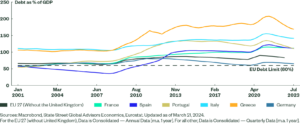Key takeaways
Bank of Canada hits pause
Last week, the Bank of Canada increased its key policy rate by just 25 basis points and decided to hit the pause button on its rate hike cycle.
Will other central banks follow?
The big question on many minds this week: Will the US Federal Reserve, European Central Bank and Bank of England (BoE) follow suit?
A ‘conditional pause’ for the US?
It is clear that of these three central banks, the Fed has the greatest ability to hit the pause button soon, and it could copy a page from Canada’s playbook.
This week is an important one in the world of monetary policy. The Bank of England, the European Central Bank and the US Federal Reserve will all be meeting this week as the world wonders, “When will they hit their respective pause buttons?” We can only hope they take their cues from the Bank of Canada.
The Bank of Canada hits the pause button
Last week, the Bank of Canada met and made the decision to increase its key policy rate by 25 basis points – the smallest of its rate hikes since March. More importantly, it decided to hit the pause button on its rate hike cycle. Bank of Canada Governor Tiff Macklem explained, “With today’s modest increase, we expect to pause rate hikes while we assess the impacts of the substantial monetary policy tightening already undertaken.”1
Now, inflation in Canada is nowhere near the central bank’s target of 2%. The headline Consumer Price Index (CPI) in Canada was 6.3% year over year in December; core CPI was 5.3% year over year.2 In fact, CPI appears to have only peaked this fall. So what is causing the Bank of Canada to hit the pause button so soon after inflation has started moderating?
I think the Bank of Canada has gained more conviction in its view that inflation is moderating sufficiently. It projects inflation to be at 3% by the end of this year, which is at the top of its target range.3 And it may be becoming more sensitive to the risks posed by its aggressive tightening — hence the language about the Bank of Canada needing to assess “the impacts” of monetary tightening that has already occurred.
Will other central banks follow suit?
And so the big question on many minds this week is: will the Federal Reserve (Fed), European Central Bank (ECB) and Bank of England (BoE) follow suit? It seems premature for these central banks to immediately follow in the Bank of Canada’s footsteps, for different reasons as each one has its own particular economic conditions and calculus to make:
- Europe. European inflation peaked in October at 10.6% and started moderating, but is at a very high level, 9.2% year over year for December.4 ECB President Christine Lagarde remains focused on bringing down inflation, and just last week reiterated her plan to continue to hike rates until they are “sufficiently restrictive” and remain at those levels until there is a “timely return of inflation to our target.”5 She may even be emboldened by the surprisingly resilient eurozone economy. S&P Global Flash Eurozone Composite Purchasing Managers’ Index released last week showed economic improvement, with the January reading back in expansion territory at 50.2, beating expectations and up from 49.3 in December.6 It’s also worth noting that the ECB began hiking later than the other major developed market central banks because of the challenges to growth raised by the wartime energy crisis and the heavy role played by energy and food prices in eurozone inflation. But now, much of the energy shock has been absorbed — plus energy prices are well off their highs in a very mild winter with high levels of energy reserves. Both these conditions are sustaining the spending power of households and firms, which in turn threatens to further entrench inflation. All signs point to tightening continuing for some time.
- United Kingdom. Inflation is even higher in the UK. It peaked in October at 11.1% year over year, and the December reading was 10.5% year over year,7 so the BoE does not have the leeway to hit the pause button any time soon. The BoE has been hiking longer, but the UK has a more challenging inflation backdrop. It faces deeper structural tightness in its labor market due to several factors, not the least of which is Brexit, which reduced the eligibility of a lot of workers from the EU to stay in or come to the UK. So the UK may well end up being more restrictive than either the Fed or the ECB because of higher inflation and inflation risks, despite the greatest recession risk.
- United States. Inflation has been moderating in the US for months now. The US Personal Consumption Expenditures (PCE) Price Index indicated inflation in line with forecasts for December: 5.0% headline, and 4.4% on core.8 This shows material improvement from November readings of 5.5% headline and 4.7% core in November.8 However, Fed Chair Jay Powell has the ghost of his predecessor Paul Volcker wandering the halls of the Fed, chomping cigars and stoking fear about inflation becoming entrenched if it is not completely vanquished now. Fear of a repeat of the late ’70s/early ’80s when the Fed “didn’t get the job done” on the first try is a powerful force at the Fed, as Powell worries about his legacy. (He clearly doesn’t want to be remembered as an Arthur Burns but as a Paul Volcker. Perhaps Powell should expand his possibilities to include Alan Greenspan as his ‘spirit central banker’?) The Fed should also be concerned about sending the US economy into a significant recession if it doesn’t hit the pause button soon.
Could the Fed institute a ‘conditional pause’?
It is clear that of these three central banks, the Fed has the greatest ability to hit the pause button soon. And it can address concerns about not finishing the job on inflation by taking a page from the Bank of Canada’s playbook. The BoC has made it clear that this is a “conditional pause”— it is dependent on “economic developments evolving broadly in line with our … outlook.”9 However, the BoC was clear that “If we need to do more to get inflation to the two-per-cent target, we will.”9
I hope a similar “conditional pause” with tough language around re-instituting hikes if economic data is not satisfactory would be enough to ease the fears of Fed hawks — and the ghost of Paul Volcker. My hope and my growing belief is that the Fed hikes rates 25 basis points this week and another 25 basis points in March — but that the March meeting comes with a “conditional pause.”
Markets will still have to contend with further central bank rate hikes, especially from the ECB and the BoE. But this shouldn’t be that much of a surprise, and the silver lining is that better-than-expected eurozone growth, along with the China re-opening, significantly reduces the short-term risk of a global recession. It points to further dollar softening as expectations take hold of a global recovery unfolding, and in my view should provide some support for risk assets in the face of earnings headwinds.
With contributions from Arnab Das
Footnotes
- 1Source: Bank of Canada, “Monetary Policy Report Press Conference Opening Statement,” Jan. 25, 2023
- 2Source: Statistics Canada, Jan. 17, 2023
- 3Source: Bank of Canada, as of Jan. 25, 2023
- 4Source: Eurostat, Jan. 18, 2023
- 5Source: Bloomberg News, “ECB Will Stay Course to Return Inflation to 2%, Lagarde Says,” Jan. 23, 2023
- 6Source: S&P Global Markit Economics
- 7Source: UK Office for National Statistics
- 8Source: US Bureau of Economic Analysis, Jan. 27, 2023
- 9Source: Bank of Canada, “Monetary Policy Report Press Conference Opening Statement,” Jan. 25, 2023
—
Originally Posted January 30, 2023
The Bank of Canada pauses: Will other central banks follow this week? by Invesco US
Important information
NA2709595
Past performance is not a guarantee of future results.
This does not constitute a recommendation of any investment strategy or product for a particular investor.
Investors should consult a financial professional before making any investment decisions.
All investing involves risk, including the risk of loss.
An investment cannot be made into an index.
Tightening is a monetary policy used by central banks to normalize balance sheets.
A basis point is one hundredth of a percentage point.
The Consumer Price Index (CPI) measures change in consumer prices. Core CPI excludes food and energy prices while headline CPI includes them.
Purchasing Managers’ Indexes are based on monthly surveys of companies worldwide, and gauge business conditions within the manufacturing and services sectors.
Personal consumption expenditures (PCE), or the PCE Index, measures price changes in consumer goods and services. Expenditures included in the index are actual US household expenditures.
The opinions referenced above are those of the author as of Jan. 30, 2023. These comments should not be construed as recommendations, but as an illustration of broader themes. Forward-looking statements are not guarantees of future results. They involve risks, uncertainties and assumptions; there can be no assurance that actual results will not differ materially from expectations.
Disclosure: Invesco US
This does not constitute a recommendation of any investment strategy or product for a particular investor. Investors should consult a financial advisor/financial consultant before making any investment decisions. Invesco does not provide tax advice. The tax information contained herein is general and is not exhaustive by nature. Federal and state tax laws are complex and constantly changing. Investors should always consult their own legal or tax professional for information concerning their individual situation. The opinions expressed are those of the authors, are based on current market conditions and are subject to change without notice. These opinions may differ from those of other Invesco investment professionals.
NOT FDIC INSURED
MAY LOSE VALUE
NO BANK GUARANTEE
All data provided by Invesco unless otherwise noted.
Invesco Distributors, Inc. is the US distributor for Invesco Ltd.’s Retail Products and Collective Trust Funds. Institutional Separate Accounts and Separately Managed Accounts are offered by affiliated investment advisers, which provide investment advisory services and do not sell securities. These firms, like Invesco Distributors, Inc., are indirect, wholly owned subsidiaries of Invesco Ltd.
©2024 Invesco Ltd. All rights reserved.
Disclosure: Interactive Brokers
Information posted on IBKR Campus that is provided by third-parties does NOT constitute a recommendation that you should contract for the services of that third party. Third-party participants who contribute to IBKR Campus are independent of Interactive Brokers and Interactive Brokers does not make any representations or warranties concerning the services offered, their past or future performance, or the accuracy of the information provided by the third party. Past performance is no guarantee of future results.
This material is from Invesco US and is being posted with its permission. The views expressed in this material are solely those of the author and/or Invesco US and Interactive Brokers is not endorsing or recommending any investment or trading discussed in the material. This material is not and should not be construed as an offer to buy or sell any security. It should not be construed as research or investment advice or a recommendation to buy, sell or hold any security or commodity. This material does not and is not intended to take into account the particular financial conditions, investment objectives or requirements of individual customers. Before acting on this material, you should consider whether it is suitable for your particular circumstances and, as necessary, seek professional advice.












![[Gamma] Scalping Please [Gamma] Scalping Please](https://ibkrcampus.com/wp-content/smush-webp/2024/04/tir-featured-8-700x394.jpg.webp)
![[Gamma] Scalping Please [Gamma] Scalping Please](https://ibkrcampus.com/wp-content/uploads/2024/04/tir-featured-8-700x394.jpg)










![[Gamma] Scalping Please [Gamma] Scalping Please](https://ibkrcampus.com/wp-content/smush-webp/2024/04/tir-featured-8-300x169.jpg.webp)
![[Gamma] Scalping Please [Gamma] Scalping Please](https://ibkrcampus.com/wp-content/uploads/2024/04/tir-featured-8-300x169.jpg)